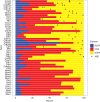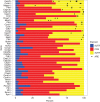Cell cycle RNA regulons coordinating early lymphocyte development
- PMID: 28231639
- PMCID: PMC5574005
- DOI: 10.1002/wrna.1419
Cell cycle RNA regulons coordinating early lymphocyte development
Abstract
Lymphocytes undergo dynamic changes in gene expression as they develop from progenitor cells lacking antigen receptors, to mature cells that are prepared to mount immune responses. While transcription factors have established roles in lymphocyte development, they act in concert with post-transcriptional and post-translational regulators to determine the proteome. Furthermore, the post-transcriptional regulation of RNA regulons consisting of mRNAs whose protein products act cooperatively allows RNA binding proteins to exert their effects at multiple points in a pathway. Here, we review recent evidence demonstrating the importance of RNA binding proteins that control the cell cycle in lymphocyte development and discuss the implications for tumorigenesis. WIREs RNA 2017, 8:e1419. doi: 10.1002/wrna.1419 For further resources related to this article, please visit the WIREs website.
© 2017 The Authors. WIREs RNA published by Wiley Periodicals, Inc.
Figures





Similar articles
-
RNA binding proteins as regulators of immune cell biology.Clin Exp Immunol. 2016 Jan;183(1):37-49. doi: 10.1111/cei.12684. Epub 2015 Sep 11. Clin Exp Immunol. 2016. PMID: 26201441 Free PMC article. Review.
-
Neurodegeneration and RNA-binding proteins.Wiley Interdiscip Rev RNA. 2017 Mar;8(2). doi: 10.1002/wrna.1394. Epub 2016 Sep 22. Wiley Interdiscip Rev RNA. 2017. PMID: 27659427 Review.
-
Post-transcriptional RNA regulons affecting cell cycle and proliferation.Semin Cell Dev Biol. 2014 Oct;34:44-54. doi: 10.1016/j.semcdb.2014.05.014. Epub 2014 Jun 2. Semin Cell Dev Biol. 2014. PMID: 24882724 Free PMC article. Review.
-
Endonuclease Regnase-1/Monocyte chemotactic protein-1-induced protein-1 (MCPIP1) in controlling immune responses and beyond.Wiley Interdiscip Rev RNA. 2018 Jan;9(1). doi: 10.1002/wrna.1449. Epub 2017 Sep 20. Wiley Interdiscip Rev RNA. 2018. PMID: 28929622 Review.
-
RNA binding protein Musashi-2 regulates PIWIL1 and TBX1 in mouse spermatogenesis.J Cell Physiol. 2018 Apr;233(4):3262-3273. doi: 10.1002/jcp.26168. Epub 2017 Oct 4. J Cell Physiol. 2018. PMID: 28884822
Cited by
-
AU-Rich Element RNA Binding Proteins: At the Crossroads of Post-Transcriptional Regulation and Genome Integrity.Int J Mol Sci. 2021 Dec 22;23(1):96. doi: 10.3390/ijms23010096. Int J Mol Sci. 2021. PMID: 35008519 Free PMC article. Review.
-
Translation factor eIF5a is essential for IFNγ production and cell cycle regulation in primary CD8+ T lymphocytes.Nat Commun. 2022 Dec 17;13(1):7796. doi: 10.1038/s41467-022-35252-y. Nat Commun. 2022. PMID: 36528626 Free PMC article.
-
Post-transcriptional regulatory patterns revealed by protein-RNA interactions.Sci Rep. 2019 Mar 13;9(1):4302. doi: 10.1038/s41598-019-40939-2. Sci Rep. 2019. PMID: 30867517 Free PMC article.
-
A new method for the treatment of myocardial ischemia-reperfusion injury based on γδT cell-mediated immune response.Front Cardiovasc Med. 2023 Aug 3;10:1219316. doi: 10.3389/fcvm.2023.1219316. eCollection 2023. Front Cardiovasc Med. 2023. PMID: 37600023 Free PMC article.
-
ZFP36L1 and ZFP36L2 inhibit cell proliferation in a cyclin D-dependent and p53-independent manner.Sci Rep. 2018 Feb 9;8(1):2742. doi: 10.1038/s41598-018-21160-z. Sci Rep. 2018. PMID: 29426877 Free PMC article.
References
-
- Pang SH, Carotta S, Nutt SL. Transcriptional control of pre‐B cell development and leukemia prevention. Curr Top Microbiol Immunol 2014, 381:189–213. - PubMed
-
- Keene JD. RNA regulons: coordination of post‐transcriptional events. Nat Rev Genet 2007, 8:533–543. - PubMed
-
- Heng TS, Painter MW, Immunological Genome Project C . The Immunological Genome Project: networks of gene expression in immune cells. Nat Immunol 2008, 9:1091–1094. - PubMed
Publication types
MeSH terms
Substances
Grants and funding
LinkOut - more resources
Full Text Sources
Other Literature Sources

